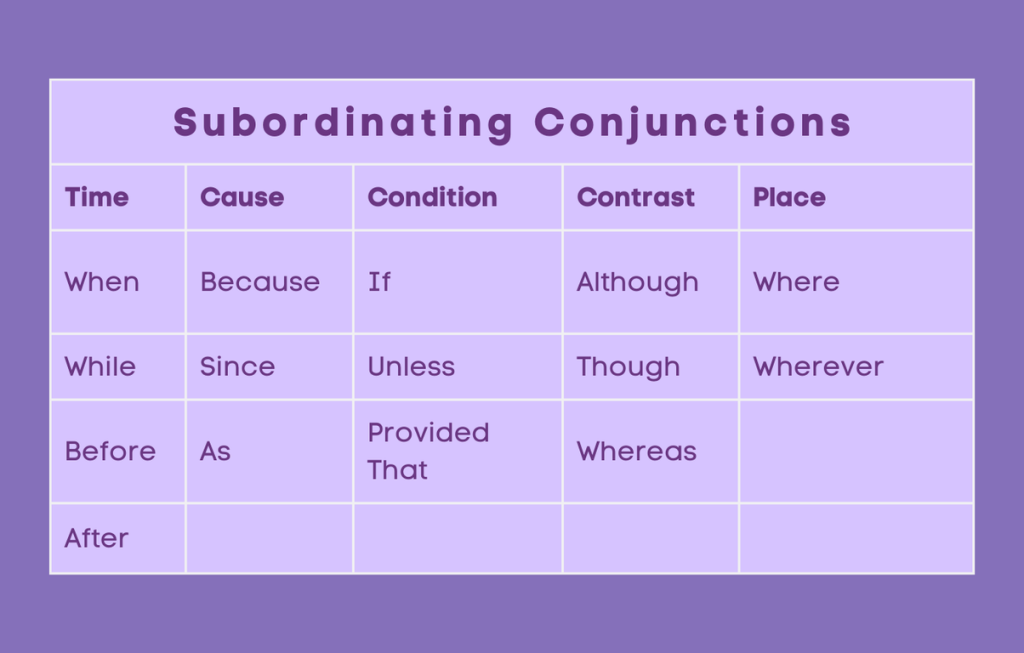Understanding Subordinating Conjunctions – Meaning and Examples
Table of Contents
Introduction
Subordinating Conjunctions
Subordinating conjunctions play a pivotal role in the construction of complex sentences, facilitating the expression of various relationships between clauses. Let’s delve into the realm of subordinating conjunctions and unravel their significance in language and communication.
Analogy of Definition
What are Subordinating Conjunctions?
Subordinating conjunctions serve as linguistic bridges, connecting dependent clauses to independent clauses and shaping the overall meaning of a sentence. They establish relationships such as time, cause, condition, and contrast between the clauses. Common examples include “after,” “because,” “if,” “while,” “although,” and “since.”
Method
Identifying Subordinating Conjunctions
Subordinating conjunctions introduce dependent clauses that cannot stand alone as complete sentences but provide additional information to the main clause. For example, in the sentence “I will go to bed early because I have an early meeting tomorrow,” “because” introduces the reason (dependent clause) for going to bed early. Subordinating conjunctions are placed at the beginning of the dependent clause and help to establish the relationship between the clauses. They are essential for creating complex sentences that convey specific meanings and relationships between ideas.
Types of Subordinating Conjunctions
1. Time
Subordinating conjunctions of time link actions or events that occur at specific points or periods. They provide temporal context and help establish the sequence of events in a sentence.
When: This conjunction introduces a dependent clause that specifies the time at which an action or event occurs in relation to the main clause.
Example: “We will go for a walk when the rain stops.”
In this sentence, “when the rain stops” specifies the condition under which the main action (going for a walk) will take place. It indicates a specific point in time when the action will occur.
2. Cause
Subordinating conjunctions of cause explain why something happens or the reason behind an action. They introduce dependent clauses that provide causal relationships to the main clause.
Because: Because introduces a reason or cause for the action or event stated in the main clause.
Example: “He couldn’t sleep because it was too noisy.”
“Because it was too noisy” explains why he couldn’t sleep. It introduces the cause (noise) that led to the effect (not being able to sleep).
3. Condition
Subordinating conjunctions of condition introduce dependent clauses that express conditions that must be met for the action or event in the main clause to occur.
If: If introduces a condition that must be fulfilled for the main clause to happen.
Example: “I will come if you invite me.”
“If you invite me” sets the condition under which the action (coming) will occur. It introduces the requirement for the main action to take place.
4. Contrast
Subordinating conjunctions of contrast introduce dependent clauses that provide contrasting information or ideas to the main clause.
Although: Although introduces a clause that presents a contrasting idea to what is stated in the main clause.
Example: “He went out for a walk although it was raining.”
“Although it was raining” introduces a contrasting circumstance (rain) to the main action (going out for a walk). It indicates a contradiction or unexpected condition.
5. Place
Subordinating conjunctions of place introduce dependent clauses that specify the location or position where an action or event occurs.
Where: Where introduces a clause that specifies the location or place where an action happens.
Example: “Put the keys back where you found them.”
“Where you found them” specifies the place (location) where the action (putting the keys back) should occur.

Examples
Example 1: Although it was raining, they decided to go for a walk.
Example 2: Because she studied diligently, she aced the exam.
Example 3: If you need assistance, feel free to ask.
The examples illustrate the use of subordinating conjunctions to connect dependent and independent clauses, expressing relationships such as contrast, cause and effect, and condition. By employing subordinating conjunctions, writers can create more complex and nuanced sentences, enhancing the depth and sophistication of their writing.
Quiz
Tips and Tricks
1. Practice Sentence Construction
Tip: Create sentences that incorporate subordinating conjunctions to convey different relationships between clauses.
2. Expand Vocabulary
Tip: Explore a variety of subordinating conjunctions to diversify your sentence structures and convey precise meanings
3. Analyze Complex Sentences
Tip: Deconstruct complex sentences to identify the role and impact of subordinating conjunctions on the overall meaning and coherence.
4. Read Widely
Tip: Expose yourself to diverse texts to observe the usage of subordinating conjunctions in different contexts and styles.
5. Seek Feedback
Tip: Share your writing with peers or mentors to receive insights on the effective use of subordinating conjunctions in your compositions.
Real life application
Scenario: The Job Interview
During a job interview, the candidate effectively utilized subordinating conjunctions to articulate their experiences and qualifications, showcasing their ability to communicate complex ideas and demonstrate their suitability for the role.
Scenario: The Classroom Presentation
A student incorporated subordinating conjunctions into their presentation, enhancing the coherence and sophistication of their speech, and effectively conveying the relationships between key concepts.\
Scenario: The Legal Argument
In a courtroom setting, the lawyer skillfully employed subordinating conjunctions to construct persuasive arguments and present compelling evidence, influencing the outcome of the case.
FAQ's
Like? Share it with your friends

